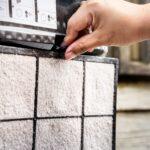We’re officially in the dog days of summer. Which means that some homeowners will find that their air conditioning isn’t keeping up. Very few things are more frustrating and uncomfortable than a poorly performing (or broken down!) air conditioner in the thick of summer. So today, we’ll explore the common reasons why air conditioners stop cooling, and hopefully get to the bottom of why your air conditioning isn’t working.
Following are all the reasons we’ll cover. They include easy-to-fix A/C issues, complex A/C challenges, and everything in between.
- Your Filter Is Clogged
- Your Vents are Blocked or Closed
- Your Thermostat Settings are Incorrect
- Your A/C’s Electrical Components are Faulty
- Your Condenser Unit is Dirty or Blocked
- Your Refrigerant Levels are Low
- Your A/C System is Aging
- Your Air Conditioner is Improperly Sized for Your Home
- Your Ductwork Needs Some Help
Let’s dive in!
Your Filter is Clogged
One of the most common reasons why your air conditioning isn’t working well is a clogged filter. The same filter serves your air conditioner and furnace, so you’ll hear the terms “A/C filter,” “furnace filter,” and “air filter” to refer to this filter, but they’re all the same thing. (And we wrote all about filters in a previous post.)
Homeowners often think their air conditioner is failing when the problem is really just a dirty filter. Throughout the year as you run your furnace and your air conditioner, the filter accumulates dust, dirt, and debris. This obstructs airflow and reduces your air conditioner’s cooling performance. It reduces your furnace’s heating performance, too.
When your filter is clogged, your air conditioner must work harder to push air through the system and throughout your home. Eventually, the stress on your A/C will lead to a system breakdown. So what starts as an easy and inexpensive problem to fix (clean and/or change your filter) can turn into a major and costly problem to fix (replace your air conditioner).
The Fix for This Problem: Clean or replace your filter, depending on whether you have a disposable or permanent one. First locate the filter, which is usually near your furnace’s air handler or behind a return air vent. If the filter is visibly dirty or clogged, clean or replace it. You can find many types and sizes of filters at big box stores and even grocery stores, as well as ordering them online. You can search for your exact filter size at Amazon or others and then get them delivered directly to your door. And most times – Amazon is the better bargain!
When the weather is really hot and you’re running your A/C every day, you may want to check the filter monthly and replace it as needed.
You can also call an HVAC pro for a tune-up, or even purchase a maintenance plan so your filter will be changed regularly without you having to think about it.
Your Vents are Blocked or Closed
This is another common reason for air conditioning that doesn’t appear to be working. Blocked or closed supply and return vents can disrupt the airflow throughout your home, leading to uneven cooling and strain on your air conditioner.
The Fix for This Problem: The solution here is usually free and doesn’t require professional services: ensure all your vents are open, unobstructed by furniture or other objects, and clean from dust and debris.
Your Thermostat Settings are Incorrect
The reason why your air conditioner isn’t working may have little to do with your air conditioner itself. The culprit may be the settings on your thermostat.
First, let’s get the obvious things out of the way:
- Your thermostat must be set to the right mode (cooling) and to the temperature you want (between 72° and 78° should do it for most homes).
- The fan should be set to “auto” so that your air conditioner can do its job of circulating air when you need it and reserving energy when you don’t.
If you’ve taken care of these things, you might consider whether you’re setting your thermostat too low. It’s natural to think that if it’s hot outside, and you’re still too hot inside, then you should set your thermostat to a lower temperature.
Well, this is true only to a point. Take note of the outdoor temperature. Now subtract 20°. The number you’re left with is the temperature that your air conditioner can reliably deliver. Air conditioners will strain to cool a home to a temperature that’s more than 20° lower than the outdoor temperature. Instead, it will run constantly, wear down, and potentially overheat.
The Fix for This Problem: Ensure your thermostat is:
- Receiving power and functioning correctly.
- Set to a temperature that’s no more than 20° lower than the outdoor temperature.
If you suspect your thermostat is faulty, you can try replacing the batteries or contacting an HVAC pro. There are lots of options for thermostats these days, including smart ones that adjust temperatures throughout the day according to weather conditions and your household routines.
Your A/C’s Electrical Components are Faulty
Air conditioning that isn’t working properly can be the result of malfunctioning or dirty electrical components, including capacitors, contactors, fan and blower motors, and various switches and connectors. When these components are worn or faulty, your A/C may fail to start, produce inconsistent cooling, or even stop working altogether.
The Fix for This Problem: Contact a professional HVAC contractor to examine your A/C equipment. An HVAC pro can safely diagnose and repair any faulty electrical components and the connections between them.
Most HVAC companies include electrical component tune-up as part of their regular maintenance services. This helps ensure that these components are always in good working order, and prevents a lot of problems before they start.
Your Condenser Unit is Dirty or Blocked
If your air conditioning isn’t working properly, your outdoor condenser unit may need some attention. The condenser is the workhorse that performs heat exchange — absorbing heat from your indoor air and releasing it to the outdoor air.
Condensers sit outside all year, and they’re built of sturdy, durable, and corrosion-resistant materials for that reason. But they are susceptible to collecting dirt, leaves, and debris, all of which find their way to the components inside too. Over time, this hinders the condenser’s performance.
The Fix for This Problem: Gently remove debris from the exterior of the condenser and use a garden hose to rinse off any dirt. Be cautious not to bend the delicate fins.
The safest way to clean your condenser is to shut off the power to it before you start. But this can be tricky, depending on where and how your condenser is positioned. So for any cleaning beyond brushing aside leaves and debris, we recommend that you let a reputable HVAC company handle it. We wrote about our A/C tune-up services in a previous post, and are happy to help you keep your condenser (and your entire HVAC system) clean and in top condition.
Your Refrigerant Levels are Low
Refrigerant is the substance that keeps you cool. It absorbs heat from your indoor air and carries it outside. Your air conditioner’s job is to circulate refrigerant, and your comfort in the summer months depends on refrigerant. We wrote all about this substance in a previous post — check it out to learn just what refrigerant is, how it works, and how it affects your home, health, and wallet.
Over time, the coils and connections in your air conditioning system can develop small leaks due to wear and tear, corrosion, or damage. These leaks allow refrigerant to escape, which lowers your refrigerant level. A low refrigerant level leads to inadequate cooling and damage to your compressor. So if your air conditioning isn’t working for you this summer, you may have a refrigerant leak.
The Fix for This Problem: Diagnosing and repairing a refrigerant leak is a job for a certified HVAC technician. Handling refrigerant demands various safety equipment and measures, many of them required by law. An HVAC pro will identify any refrigerant leaks you have, determine the root cause, make the necessary repairs, and then recharge your system with the correct amount of refrigerant.
Your A/C System is Aging
If your air conditioning isn’t working, you might have an aging appliance on your hands. Like all other appliances, air conditioners have a limited lifespan. In fact, the average lifespan of central air conditioning systems in the U.S. is 10 to 15 years. So if you’re in an older home or a home built with entry-level HVAC more than 10 years ago, your air conditioner’s age could be your issue.
We’ll pause right here to say that if you invest in a quality HVAC brand, make sure that it’s installed properly by a reputable HVAC company, and take care of it with regular professional maintenance, your A/C can last 20 to 25 years or even longer.
But eventually, age will catch up with even the highest-quality air conditioner. Its components will degrade with wear and tear, and you’ll start noticing that your home is never quite cool enough. You might also notice loud noises, unpleasant smells, and a compressor that never stops running. If any of the above describes your situation, your A/C repairs are likely to become more frequent and more costly (if they aren’t already).
The Fix for This Problem: Contact an HVAC pro to assess your current A/C system and discuss the benefits of upgrading to a newer, more energy-efficient model. You may be at the replacement point: that place where A/C breakdowns are more expensive than a new system. Plus, investing in new A/C will likely save you money on your energy bills, too.
Your Air Conditioner is Improperly Sized for Your Home
An air conditioner that isn’t working may be a model that is too large or too small for your home.
In the context of air conditioners, “large” and “small” refer to cooling capacity, measured in BTUs. So when we say an air conditioner is too large or too small for your home, we mean that its cooling capacity is too much or too little for the amount that your home needs.
Let’s start with the “too large” problem. Homeowners often think that a larger air conditioner is a better air conditioner. But believe it or not, a large air conditioner causes a lot of problems in a smaller home.
An oversized A/C unit cools a smaller space rapidly. This causes it to short cycle, which means cycling on and off very quickly and repetitively. Short cycling leads to excess wear and tear on your A/C system. It also fails to dehumidify your indoor air properly, because your A/C isn’t running long enough to remove moisture from the air. This can lead to a clammy and uncomfortable indoor environment, and eventually mold growth.
The “too small” problem is a lot more straightforward to understand: an undersized A/C unit struggles to keep up with your cooling demands and can’t treat the volume of air in your home. This results in undue stress on your A/C system and high energy bills, and still your home isn’t cool enough.
The Fix for This Problem: If you suspect that your air conditioner is too large or small for your home, you should consult with an experienced HVAC technician to perform a load calculation. This calculation takes into account the size of your home, its floor plan, its insulation, window placement, and other factors to determine the ideal A/C size for your needs. Upgrading to the right-sized unit will do wonders for your comfort and your wallet.
Your Ductwork Needs Some Help
Your ductwork is the pathway through which cooled air travels from your A/C to all the rooms of your home. If your air conditioning isn’t working well, the problem may be your ductwork rather than your air conditioner itself.
Poor ductwork is like a poor highway that causes traffic bottlenecks. Here are some of the problems that ducts can have:
- They can be too small for your home, which restricts air flow and produces hot spots.
- Ducts can develop leaky connections between them, which allows cooled air to escape into unused spaces, such as your attic or crawl spaces. This means that the cooled air isn’t fully reaching its intended target: your living spaces.
- Ductwork often has poorly designed transitions, which results in poor air circulation and cooling levels.
We see a lot of subpar ductwork out there. Often this is not because of negligence on the part of the HVAC companies who installed it. Instead, it’s often because home renovations over time didn’t include corresponding ductwork upgrades.
Ultimately, if your home’s ductwork has sizing or quality issues, there’s no air conditioner on the market that will compensate for the problems that result.
The Fix for This Problem: Have an experienced HVAC contractor inspect your ductwork to identify any sizing, design, or performance issues. In some cases, ducts may only need proper sealing to stop air leaks. In other cases, modifications may be necessary to ensure proper airflow. Upgrading to larger, well-designed ducts can be the key to unlocking your A/C’s true efficiency.
One of our specialties here at Kowalski Heating, Cooling, and Plumbing is custom-designed ductwork. We create elegant, seamless, high-performing ductwork for your unique home.
_____________
Are you suffering this summer with an air conditioner that doesn’t seem to be doing its job? We’ll figure out the problem and provide you with a solution that works for your budget. Plus, our estimates are free, and we’ll get you on the schedule quickly.
Call or text us at 412-952-5923. You can also contact us via our website at any time. We look forward to serving you!





